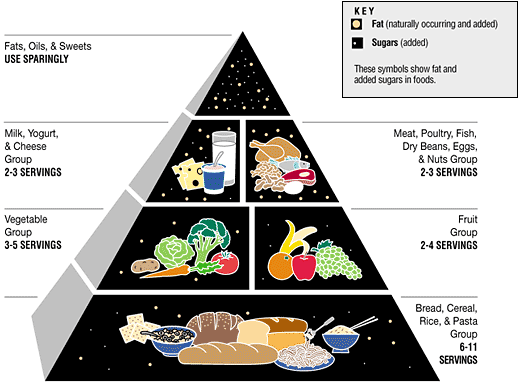We’ve
all heard the message.
Lean bodies produced by sound nutrition,
cardiovascular exercise and resistance training will
reduce the risks of cancer, stroke, heart disease and
type II diabetes. Now,
new research shows that caloric restriction can stop the
cell death process associated with age.[i][i]
As a result
of a continuing multi-media message, countless numbers
of people are dieting.
Low-fat, low-carb, high-protein, The Zone, Sugar
Busters, Atkins, Weight-Watchers and the Diet Center are
just a few examples in an ever-expanding growth
industry. Billions
of dollars are spent each year on efforts to lose weight
and yet the population grows fatter each day.
Usually
thought of as an American problem, obesity and its
effects are currently spreading far beyond the US
borders. “Worldwide, a billion people are now
overweight or obese, including 22 million children under
the age of 5. Obesity and ills linked to it, including
heart disease and high blood pressure, have joined the
World Health Organization's list of the Top 10 global
health risks. Rates of obesity are going up in
developing countries as well as industrialized ones,
with the greatest increases taking place in the last 10
years. In the United States, 64.5 percent of adults and
15 percent of children ages 6 to 19 are overweight.”[ii][ii]
 But,
herein lies the problem.
A billion people are overweight and billions more
are spent on dieting to reduce pounds.
Blame is placed on the food pyramid, reduced
exercise standards, super-sized portions of food,
carbohydrates and general confusion about which diet
plan will work for the consumer.
Who is really to blame for an epidemic where
costs are far reaching?
Obesity is not limited to the physical effects on
the overweight individual, but rather expands to include
increased health-related costs to businesses with
overweight workers, stress on families when a loved one
is diagnosed with a weight-related health disorder and
psychological factors for the overweight person.
But,
herein lies the problem.
A billion people are overweight and billions more
are spent on dieting to reduce pounds.
Blame is placed on the food pyramid, reduced
exercise standards, super-sized portions of food,
carbohydrates and general confusion about which diet
plan will work for the consumer.
Who is really to blame for an epidemic where
costs are far reaching?
Obesity is not limited to the physical effects on
the overweight individual, but rather expands to include
increased health-related costs to businesses with
overweight workers, stress on families when a loved one
is diagnosed with a weight-related health disorder and
psychological factors for the overweight person.
It’s
time to start placing blame where blame is due.
From
the food pyramid and super-sized portions to a sedentary
lifestyle embraced by the next generation, let’s
examine current thinking on the set of variables that
lead to the worldwide obesity epidemic.
A sedentary lifestyle is in large part to blame for the
current obesity crisis.
Many experts compare yesterday’s
agricultural society where long hours of hard labor in
the fields kept generations lean, with today’s
cyberspace society where days and nights are
spent sitting in front of a computer screen. Rather than
adjust dietary needs with fewer calories to match the
less physical lifestyle, calories have dramatically
increased through fast-food, prepared foods and dining
out.
As
a society we’ve become parochial in our vision,
focusing only on the short-term to get ahead in the
current competitive work environment. Rather than acknowledge that a fit and lean body will produce
more efficient results in the long-term, the myopic view
remains on production, NOW.
As a result, the benefits of time away from the
job are rarely studied and implemented by the overweight
population.
Unfortunately,
this sedentary lifestyle has been passed down to our
children. When
was the last time an impromptu game of kickball,
stickball or tag broke out in your neighborhood?
Yes, I’m dating myself, but for those of you in
my babyboomer age bracket, think back to your childhood.
How many children in your neighborhood were
obese? Zero,
in mine. Perhaps,
one or two in a neighborhood of fifty children were a
bit on the chubby side.
But, by today’s standards those very same
children would be considered normal in size.
We’ve
changed the standards not only in size, but
expectations.
“Our sedentary habits led public-health
officials to pursue a dramatic shift in exercise
recommendations in the mid-1990s.
For years, the emphasis had been on getting the
heart revved at least three times a week through
vigorous aerobic activity like running, as recommended
by the American College of Sports Medicine in 1978.
But as it became increasingly clear that only a
sliver of the population was actually going to leap up
and start sprinting, researchers realized there was an
urgent need to scale back expectations.”[iii][iii]
 Intensity
was replaced with moderation.
Running and sprinting were replaced with brisk
walking or gardening.
And we wonder why this costly health epidemic
continues.
Intensity
was replaced with moderation.
Running and sprinting were replaced with brisk
walking or gardening.
And we wonder why this costly health epidemic
continues.
Dr.
Rena Wing, a leading obesity researcher has identified
3000 successful weight loss people, those that lost an
average of sixty pounds and kept the weight off for
three of more years[iv][iv].
Through her work, Dr. Wing identified several
factors that lead to successful long-term weight loss.
Individuals in her study burned an average of
2800 calories per week through exercise.[v][v]
The studies clearly show that exercise must be
given priority.
Yes,
much research can be found that supports the lower risks
of heart disease with only 30 minutes of daily vigorous
activity. But,
“60 minutes of physical activity was necessary to
maintain body weight and avoid excess gain.”[vi][vi]
No wonder people are getting frustrated! Expecting results through a 30-minute exercise regime, when
daily 60-minute sessions are required for success brings
the word epidemic to light.
So,
the public is justifiably frustrated.
They’ve been given data that will improve their
health risks, but not reduce their bulge.
But, even with the drastic reduction in
standards, designed to engage the masses in the fight
against immobility and obesity, “only 1 in 5 US adults
get the recommended amount of physical activity,
according to a 1996 Surgeon General’s report.”[vii][vii]
It is clear, we need to start taking
responsibility for the food we put in our mouths and the
amount of calories we burn through exercise.
Many
are blaming the food pyramid for the current state of
obesity.
Everywhere you look a writer, newscaster or diet
guru is taking a shot at the current Food Guide Pyramid
that was designed in 1992 by the USDA. “The pyramid is
a disaster, says K. Dun Gifford of Oldways, a non-profit
think tank based in Boston.
The American epidemic of obesity is the proof
that it hasn’t worked.
Period. Amen.”[viii][viii]
Clearly,
for athletes and bodybuilders, many flaws are seen in
the current Food Guide Pyramid, but exception must be
taken with K. Dun Gifford’s remark.
Fast food, fried in obscene amounts of artery
clogging oil does not have a place on the current
pyramid. And
yet, many fast-food meals are part of the typical diet
of an overweight person.
Adding the extra calories from fast food to the
pyramid, or worse yet, replacing the healthy and
nutrient dense fruits and vegetables on the current food
pyramid has lead to the fattening up of the world.
Couple
the FDA Food Guide Pyramid with the marketing genius of
convincing the public that low-fat foods can be eaten in
abundance is also to blame for the current set of
affairs. How
is it possible that the majority of the population is
convinced that low-fat somehow means no calorie? Yes,
eat low-fat green peppers, celery and broccoli in
unlimited quantities, but low-fat cookies?
“We were trying to promote lean meats and
low-fat dairy products, says Marion Nestle, a New York
University nutritionist who served as an adviser to the
surgeon general in the late 1980s.
We never thought of Snackwell’s”[ix][ix]

Society
has forgotten the concept of portion size.
In a
fast-paced, instant gratification world, people want
satisfaction, in large quantities, RIGHT NOW! We’ve learned to equate large portions with a sense of
value. Watch
any TV news program and you’ll see a comparison of a
serving size of yesterday with a serving size of today.
Back to those babyboomers, remember a single
portion of McDonald’s fries?
That portion seemed to satisfy us and at 200
calories coupled with a bike ride or walk to the local
McDonalds, the calories were burned off in our quest for
this occasional treat.
Today, a super-sized portion valued at more than
600 calories adds to the bulging of society that uses
the drive-up window on a daily basis.
It’s
time to start rethinking the concept of value by taking
the emphasis off of size and placing it on health.
We need to realize that it’s very easy and
inexpensive for fast-food restaurants to just throw in
more food, and start paying attention to research
studies that compare serving size and the amount of
calories ingested.
“When we gave people big buckets of
popcorn—the ones you have to hold with two hands—at
a movie theater, they ate 40 to 50 percent more popcorn
than people who got smaller buckets, says Brian Wansink,
director of the Food and Brand Research lab at the
University of Illinois at Urbana-Champaign.”[x][x]
Feel cheated that movie theatres don’t offer
any nutritious alternatives rather than extra-large
popcorn at $6.00 is only a dollar more than the small
sized indulgence.
Overweight
people feel confused by the myriad of diet plans. Granted, countless weight reduction plans are in existence.
Each boldly touts success through sugar
elimination, carbohydrate reduction increased protein
intake or point systems.
Those in search of the magic bullet to bring
physique transformation success become bogged down in
the minutia of individual plans.
Weight loss consultants will admit that far too many clients get stuck in
the science of weight reduction, rather than the simple
process of taking in fewer nutrient dense calories than
expended. When
many excess pounds are needed to lose, the process is so
simple. For
a client with much weight to lose, the difference in
pounds lost when consuming a baked potato versus brown
rice is minimal and clearly should not be allowed to
stunt the success of someone that truly as the desire to
lose weight.
Each
adult individual is responsible for the amount of
calories ingested and burned on a daily basis. Almost
any plan that reduces calories, limits fat and controls
portion size will work when coupled with exercise done
on a daily basis. Health
is not an area where we should make compromises.
It is time we start taking responsibility and
place the blame for this expanding crisis right at the
individual level, for it is the individual that
determines the quantities of food ingested and whether
or not that food is stored as fat or burned as the
body’s fuel.
So,
keep it simple and start today!
Obesity
prescription
1.
Move
more! Start
slow with the goal to build both endurance and
intensity.
2.
Eat
less! Record
every bite and re-evaluate portion size.
3.
Take
responsibility for your actions!
4.
Stop making excuses and just do it!